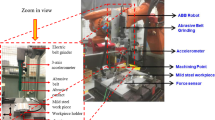Abstract
Tool wear has a significant influence on machining processes. Investigations on tool wear monitoring through various methods and sensors have been widely conducted to determine and predict the tool wear. In this study, sound generation mechanisms during turning process have been investigated comprehensively and three sound generation sources have been determined and distinguished. Then, the relation between the sound generation mechanisms and chip formation has been studied during machining using sharp and worn tool. Hence, a deep understanding about the machining process has been brought out. Findings have led to an effective approach to monitoring the machining process, not only using mathematical signal processing methods, but also through a physical comprehension background. A healthy signal independent feature has been proposed to determine the machining condition regarding the perception about the sound generation mechanisms. Extracted features from the sound signals which have been acquired through experimental tests have shown the effectiveness of the purposed approach.




































Similar content being viewed by others
Availability of data and material
Data and materials are available and can be shared upon request.
Code availability
Any code and simulation data are available and can be shared upon request.
References
Kovač P et al (2011) A review of machining monitoring systems. J Prod Eng 14(1):1–6
Lebar A et al (2010) Method for online quality monitoring of AWJ cutting by infrared thermography. CIRP J Manuf Sci Technol 2(3):170–175
Nasir V, Cool J, Sassani F (2019) Intelligent machining monitoring using sound signal processed with the wavelet method and a self-organizing neural network. IEEE Robot Autom Lett 4(4):3449–3456
Ahmad MAF et al (2015) Development of tool wear machining monitoring using novel statistical analysis method, I-kaz™. Procedia Eng 101:355–362
Plaza EG, López PN, González EB (2019) Efficiency of vibration signal feature extraction for surface finish monitoring in CNC machining. J Manuf Process 44:145–157
Inasaki I (1998) Application of acoustic emission sensor for monitoring machining processes. Ultrasonics 36(1–5):273–281
Oliveira TLL et al (2020) Smart machining: Monitoring of CFRP milling using AE and IR. Compos Struct 249:112611
Ong P, Lee WK, Lau RHJ (2019) Tool condition monitoring in CNC end milling using wavelet neural network based on machine vision. Inte J Adv Manuf Technol 104(1):1369–1379
Kao JY, Tarng YS (1997) A neutral-network approach for the on-line monitoring of the electrical discharge machining process. J Mater Process Technol 69(1–3):112–119
Chen SL, Jen YW (2000) Data fusion neural network for tool condition monitoring in CNC milling machining. Int J Mach Tools Manuf 40(3):381–400
Lee WJ et al (2019) Predictive maintenance of machine tool systems using artificial intelligence techniques applied to machine condition data. Procedia Cirp 80:506–511
Lee CH et al (2020) An intelligent system for grinding wheel condition monitoring based on machining sound and deep learning. IEEE Access 8:58279–58289
Serin G et al (2020) Review of tool condition monitoring in machining and opportunities for deep learning. Int j Adv Manuf Technol 109(3):953–974
Ahmed YS, Arif AFM, Veldhuis SC (2020) Application of the wavelet transform to acoustic emission signals for built-up edge monitoring in stainless steel machining. Measurement 154:107478
Mohanraj T et al (2021) Development of tool condition monitoring system in end milling process using wavelet features and Hoelder’s exponent with machine learning algorithms. Measurement 173:108671
Maged A et al (2018) Statistical monitoring and optimization of electrochemical machining using Shewhart Charts and response surface methodology. Int J Eng Mater Manuf 3(2):68–77
Komanduri R, Von Turkovich BF (1981) New observations on the mechanism of chip formation when machining titanium alloys. Wear 69(2):179–188
Shaw MC, Vyas A (1998) The mechanism of chip formation with hard turning steel. CIRP Ann 47(1):77–82
Che J et al (2020) Experimental and numerical studies on chip formation mechanism and working performance of the milling tool with single abrasive grain. J Pet Sci Eng 195:107645
Liu Qi et al (2021) Mechanism of chip formation and surface-defects in orthogonal cutting of soft-brittle potassium dihydrogen phosphate crystals. Mater Des 198:109327
Balogun VA et al (2016) Specific energy based evaluation of machining efficiency. J Clean Prod 116:187–197
Guo YB, Chou YK (2004) The determination of ploughing force and its influence on material properties in metal cutting. J Mater Process Technol 148(3):368–375
Ghosh S, Chattopadhyay AB, Paul S (2008) Modelling of specific energy requirement during high-efficiency deep grinding. Int J Mach Tools Manuf 48(11):1242–1253
Sarwar M et al (2009) Measurement of specific cutting energy for evaluating the efficiency of bandsawing different workpiece materials. Int J Mach Tools Manuf 49(12–13):958–965
Xiuli Fu et al (2018) Morphology evolution and micro-mechanism of chip formation during high-speed machining. Int J Adv Manuf Technol 98(1):165–175
Prakash M, Kanthababu M, Rajurkar KP (2015) Investigations on the effects of tool wear on chip formation mechanism and chip morphology using acoustic emission signal in the microendmilling of aluminum alloy. Int J Adv Manuf Technol 77(5):1499–1511
Astakhov VP (2005) On the inadequacy of the single-shear plane model of chip formation. Int J Mech Sci 47(11):1649–1672
Siddhpura A, Paurobally R (2012) A study of the effects of friction on flank wear and the role of friction in tool wear monitoring. Aust J Mech Eng 10(2):141–156
Guo Y, Compton WD, Chandrasekar S (2015) In situ analysis of flow dynamics and deformation fields in cutting and sliding of metals. Proc R Soc A Math Phys Eng Sci 471(2178):20150194
Author information
Authors and Affiliations
Corresponding author
Ethics declarations
Ethics approval
This study does not involve human/animal participants. Therefore, ethics approval is not applicable.
Consent to participate
This study does not involve human participants. Therefore, consent to participate is not applicable.
Consent for publication
This study does not involve human participants. Therefore, consent for publication is not applicable.
Conflict of interest
The authors declare no competing interests.
Additional information
Publisher's note
Springer Nature remains neutral with regard to jurisdictional claims in published maps and institutional affiliations.
Rights and permissions
About this article
Cite this article
Nourizadeh, R., Rezaei, S.M., Zareinejad, M. et al. Comprehensive investigation on sound generation mechanisms during machining for monitoring purpose. Int J Adv Manuf Technol 121, 1589–1610 (2022). https://doi.org/10.1007/s00170-022-09333-7
Received:
Accepted:
Published:
Issue Date:
DOI: https://doi.org/10.1007/s00170-022-09333-7




